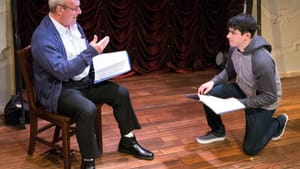Stay in the Loop
BSR publishes on a weekly schedule, with an email newsletter every Wednesday and Thursday morning. There’s no paywall, and subscribing is always free.
A glimpse behind the curtain
Mamet’s ‘Life in the Theatre’ at the Walnut Street Theatre

David Mamet’s Life in the Theatre reminds us that the characters we see on stage are created by actors who work at their craft. The play gives us a glimpse behind the scenes, in a shared dressing room, and on stage, positioning the proscenium to an imaginary audience upstage, as if we, the actual audience, were behind the actors watching them work.
The two actors, the brash young John (played by Davy Raphaely, who recently appeared at the Independence Studio in Bad Jews) and the older, affected Robert (played by Bill Van Horn, who also directed the play) share a dressing room and appear together over time in a variety of plays — some modern, some classics, some with the cadences of Shakespeare or Chekov, and some with a pirates’ brogue. They play soldiers and surgeons and men cast adrift on the sea. And always they are there for each other, even if the sense of competition between them never quite goes away.
Several plays lately have demanded that the actors play many parts, and here the actors go through the paces of any working actor, shifting from one role to the next with a change of voice, accent, posture, costume, wig, over 40 costume changes in all. Disasters ensue — a missed cue, a forgotten line, a zipper that needs to be pinned, a wig gone askew.
Tolerance and reliance
The characters never grow close, they don’t much grow at all, but they come to tolerate each other, and as they age through the play, they come to rely on each other.
Mamet, being Mamet, cannot resist making it clear to us that although women are not part of this play, we can blame them for any problems that occur. And having made sure we know that in the first few minutes of the play, the concept of woman disappears from the stage, and Mamet can get on with the business of showing what happens to men as they go through life unencumbered. His characters don’t even have real relationships. They are totally immersed in the theater and in the imagined connections they have with each other and the characters on stage.
The play is fun as it speeds along from one mediocre play to the next. There’s no sense that these actors are masters of their craft, but they work hard at what they do. Raphaely’s John is brash and optimistic, while Van Horn’s aging Robert starts to forget his lines, confuses the scene he’s in. He’s aware that he’s losing it, afraid of what’s to come, yet he perseveres. He needs to keep pretending.
We’re not all actors, but we show up day after day, reciting our lines, playing our parts. We begin as students of those who were there before, come into our own, and then become mentors to the next generation. It’s not as neat or as funny as Mamet’s play, and we don’t have an audience watching us at work, but it is the play we’re cast in and we are the stars of our own production.
What, When, Where
A Life in the Theatre. By David Mamet, Bill Van Horn directed. Through February 1, 2015 at Walnut Street Theatre Independence Studio on 3, 825 Walnut St., Philadelphia. 215-574-3550 or www.walnutstreettheatre.org.
Sign up for our newsletter
All of the week's new articles, all in one place. Sign up for the free weekly BSR newsletters, and don't miss a conversation.
 Naomi Orwin
Naomi Orwin